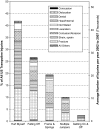Effectiveness of pads and enclosures as safety interventions on consumer trampolines
- PMID: 20570986
- PMCID: PMC2989161
- DOI: 10.1136/ip.2009.025494
Effectiveness of pads and enclosures as safety interventions on consumer trampolines
Abstract
Background: Trampolines continue to be a major source of childhood injury.
Objective: To examine available data on trampoline injuries in order to determine the effectiveness of padding and enclosures.
Design: Trampoline injuries from the NEISS database from 2002 to 2007 were reclassified into five cause-categories, to examine evidence for injury trends.
Setting: The ASTM trampoline standard recommendations for safety padding were upgraded in 1999 and enclosures were introduced in 1997. This is the first study to examine the impact of these changes.
Patients: The sampling frame comprises patients with NEISS product code 'consumer trampolines' (1233). A systematic sample of 360 patients each year is taken.
Interventions: The prominent interventions recommended by the ASTM are netting enclosures to prevent falling off and safety padding to cover frames and springs.
Main outcome measures: Proportion of injuries within each cause-category and trend estimates.
Results: There was no evidence for a decline within the injury cause-categories that should be prevented by these interventions from 2002 to 2007.
Conclusions: If these interventions were effective the associated injury causes would be in decline. Instead they remain close to half of all trampoline injuries with no significant change over the period of the study. Follow-up studies are proposed to determine the reasons. Given the number of injuries involved it is recommended that steps be taken to ensure these safety interventions or their equivalents are in place, work properly and remain effective for the life of consumer trampolines.
Conflict of interest statement
Figures



Similar articles
-
Injuries to children in the United States related to trampolines, 1990-1995: a national epidemic.Pediatrics. 1998 Mar;101(3 Pt 1):406-12. doi: 10.1542/peds.101.3.406. Pediatrics. 1998. PMID: 9481005
-
Paediatric injury from indoor trampoline centres.Inj Prev. 2017 Oct;23(5):352-354. doi: 10.1136/injuryprev-2016-042071. Epub 2016 Aug 15. Inj Prev. 2017. PMID: 27528404
-
Australian trampoline injury patterns and trends.Aust N Z J Public Health. 2015 Oct;39(5):491-4. doi: 10.1111/1753-6405.12404. Epub 2015 Jun 29. Aust N Z J Public Health. 2015. PMID: 26123781
-
Trampoline injuries.Clin Orthop Relat Res. 2003 Apr;(409):43-52. doi: 10.1097/01.blo.0000057783.10364.5b. Clin Orthop Relat Res. 2003. PMID: 12671484 Review.
-
All-terrain vehicle, trampoline and scooter injuries and their prevention in children.Curr Opin Pediatr. 2006 Jun;18(3):260-5. doi: 10.1097/01.mop.0000193307.37709.dc. Curr Opin Pediatr. 2006. PMID: 16721145 Review.
Cited by
-
Incidence of patients with lower extremity injuries presenting to US emergency departments by anatomic region, disease category, and age.Clin Orthop Relat Res. 2012 Jan;470(1):284-90. doi: 10.1007/s11999-011-1982-z. Epub 2011 Jul 22. Clin Orthop Relat Res. 2012. PMID: 21785896 Free PMC article.
-
Survey of injury sources for a trampoline with equipment hazards designed out.J Paediatr Child Health. 2012 Jul;48(7):577-81. doi: 10.1111/j.1440-1754.2012.02426.x. Epub 2012 Mar 7. J Paediatr Child Health. 2012. PMID: 22404557 Free PMC article.
-
A Measurement of 'Walking-the-Wall' Dynamics: An Observational Study Using Accelerometry and Sensors to Quantify Risk Associated with Vertical Wall Impact Attenuation in Trampoline Parks.Sensors (Basel). 2021 Nov 4;21(21):7337. doi: 10.3390/s21217337. Sensors (Basel). 2021. PMID: 34770643 Free PMC article.
-
Specific injuries induced by the practice of trampoline, tumbling and acrobatic gymnastics.Knee Surg Sports Traumatol Arthrosc. 2013 Feb;21(2):494-9. doi: 10.1007/s00167-012-1982-x. Epub 2012 Apr 5. Knee Surg Sports Traumatol Arthrosc. 2013. PMID: 22476523
-
Trampoline injuries in the world and in Turkey.Turk J Phys Med Rehabil. 2017 Jul 31;63(3):275-280. doi: 10.5606/tftrd.2017.1321. eCollection 2017 Jun. Turk J Phys Med Rehabil. 2017. PMID: 31453466 Free PMC article. Review.
References
-
- US Standard ASTM F381-06 Standard Consumer Safety Specification for Components, Assembly, and Use of a Trampoline. 2006
-
- US Standard ASTM F2225-09 Standard Safety Specification for Consumer Trampoline Enclosures. 2009
-
- NEISS database http://www.cpsc.gov/LIBRARY/neiss.html (accessed 10 May 2009).
-
- American Academy of Pediatrics Committee on Injury and Poison Prevention and Committee on Sports Medicine and Fitness Trampolines at home, school, and recreational centers. Pediatrics 1999;103:1053–6 - PubMed
MeSH terms
LinkOut - more resources
Full Text Sources
Medical
